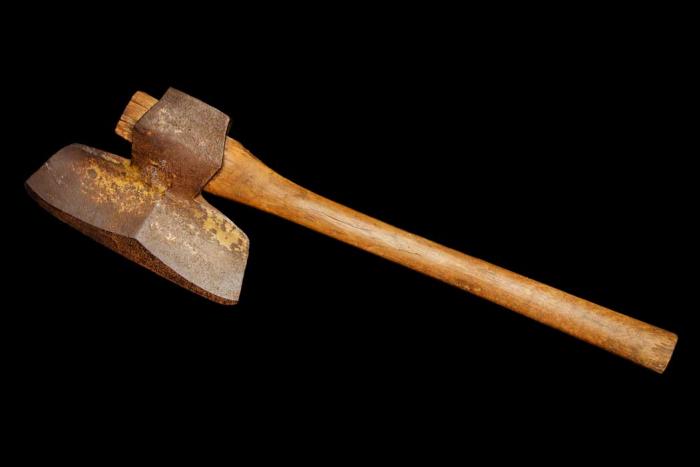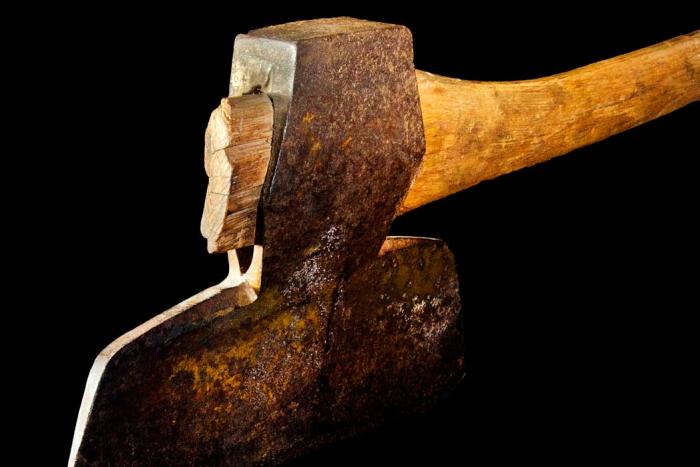Broad Axe
Organization: Gatineau Valley Historical Society
Coordinates: www.gvhs.ca
Address: Box 1803, Chelsea, QC, J9B 1A1
Region: Outaouais
Contact:Carol Martin, info(a)gvhs.ca
Description: Broad axe used by the early settlers of the Gatineau Valley.
Year made: circa 1860-1900
Made by: Unknown
Materials/Medium: Wood, iron, steel
Colours: Brown, black
Provenance: Owned by the Sheffield family of Old Chelsea, Quebec.
Size: 30.4 cm x 68.5 cm (weighs 8.4 pounds, with a 12-inch blade and a 27-inch helve)
Photos: David Irvine. Courtesy Gatineau Valley Historical Society
The Broad Axe
Carol Martin and Dave Yuill
The broad axe, the logo chosen by the Gatineau Valley Historical Society (GVHS), is symbolic of the earliest days of this region’s settlement. An indispensable tool used for personal needs to square timber to build log houses, construct timber-frame buildings, and for larger projects such as building bridges and dams, the broad axe was also the basic tool required in lumbering, the first industry in the region.
In the 1800s, a group of Americans led by Philemon Wright, arrived in Hull Township on the north shore of the Ottawa River, and took up land to begin an agricultural settlement. As the settlers cut their timber to clear the land, Wright soon learned that there was a market for the timber in Montreal and Quebec, and sent a raft of square timber down the Ottawa River in 1806. Harvesting the stands of white and red pine in the Ottawa Valley provided the economic base supporting the early settlements, and an incentive for the population to expand into surrounding territory where timber was plentiful.
As a counterbalance to farming, whose main activities took place during spring, summer and autumn, lumbering offered alternate employment for farmers during the winter months. For others, particularly where land was not suitable for farming, lumbering became a year-round occupation. The massive stands of pine that were the basis of the timber trade grew in the valleys of the Gatineau, the Lièvre, the Coulonge and Black Rivers on the Quebec side of the Ottawa, and the Madawaska and Mississippi on the Ontario side.
Along with household goods and livestock, a broad axe was one of the essential tools brought by the pioneers who settled Hull Township and the Ottawa Valley, along with the chopping or felling axe, used to cut down trees and trim branches. With its heavier head, the broad axe has a handle that is offset from the blade so that the flat face of the blade can make contact with the wood, and the other side of the blade has a chisel edge.
Various American companies manufactured broad axes, and a North American style and weight evolved from earlier designs produced and exported from British sources. The Wright settlement in western Quebec soon became self-sufficient in axe-manufacture. A forge and blacksmiths trained in the United States repaired and produced broad axes, among other essential tools. By the 1840s, an axe-making industry had developed in Hull and Ottawa. The largest and heaviest broad axes were made in or for the Ottawa Valley, in a distinctive design with a small poll (the point where the handle joins the head) and a broad blade that became known as the "Canada pattern." These axes were as heavy as 5.4 kilograms (8.4 pounds), and had heads made of iron with cast steel-edged blades as wide as 38 centimetres (14 inches). An idea of the value of axes in the late 1830s comes from an Ontario firm’s catalogue (Andrew Hurd & Co., of Maitland, Ont.), whose broad axes sold for the equivalent of two week’s pay, while their chopping axes cost half that. By the end of the century they could be bought with the earnings of an hour or two.
The GVHS broad axe design was sketched by one of the Society’s founding members, Isobel "Lid" Ryan. Lid and her husband, Ed Ryan, lived on a property in Old Chelsea whose deed to the Sheffield family traces to 1823, and whose historic barns still contain many of the tools used by them. Elisha Sheffield, the progenitor of this family, had married Philemon Wright’s niece, Mary, in 1806. He had arrived as a single man among the first group of settlers; he stated on the census conducted in November 1842 that he had arrived 43 years earlier.
The Sheffield family axe depicted in the GVHS logo weighs 3.8 kilograms (8.4 pounds), with a 30.4-centimetre blade (12 inches) and a 68.5-centimetre (27 inches) handle. The axe head is mounted for left-handed use, a relative rarity for which the worker received a higher daily rate than a right-handed worker, since he was able to work simultaneously with a right-handed man, getting the job done faster. Its commercially-made axe head carries no markings, but its style and Canadian pattern place its manufacture in the latter half of the 19th century. Between 1860 and 1915, the Ottawa Valley had 150 axe-makers.
In July 1986 the Gatineau Valley Historical Society authorized purchase of a broad axe from Ottawa’s Bytown Museum for $50, to use for display purposes. That axe, also unmarked, is also a Canada axe, with a 30.4-centimetre (12 inches) blade and a 68.5-centimetre (27 inches) helve. Broad axes are now valued as mementos and a reminder of pioneer days, instead of being kept for regular use. They have a decorative appeal that chopping axes lack. The Sheffield family axe that inspired Lid Ryan’s logo for the GVHS is still displayed on a wall of the Sheffield family house.
Sources
Doug S. Orr, Ottawa, Ontario, antique tool consultant.
John W. Hughson, and Courtney C. J. Bond, Hurling Down the Pine, 2nd edition. The Historical Society of the Gatineau, 1965.
Gary E. French, Axe Making in Ontario in the Settlement Period. East Georgian Bay Historical Foundation, 2010.
Bruce S. Elliott, “Philemon Wright (1760-1839),” Up the Gatineau!, Volume 26.
Archie Pennie, “Squaring the Log,” Up the Gatineau!, Volume 20.
Archie Pennie, “When the Axe was King,” Up the Gatineau!, Volume 24.
To Learn More
R.A. Salaman, Dictionary of Tools used in the woodworking and allied trades c.1700-1970, 1975.
Henry Chapman Mercer, Ancient Carpenter’s Tools: together with lumbermen's, joiners' and cabinetmakers' tools in use in the 18th century, 1975.
Lumbering www.canadianheritage.org
Donald MacKay, The Lumberjacks, 2007.
Michael E. Vance, Imperial Immigrants: Scottish Settlers in the Upper Ottawa Valley 1815-1840, 2012.
Authors
Carol Martin is an historian and writer and long-time executive member of the Gatineau Valley Historical Society. Dave Yuill is an executive member of the Gatineau Valley Historical Society and is an antique tool enthusiast.










Comments
Broad Axe identification
To whom it may concern, I have an old broad axe that I inherited. It looks identical to the one pictured in this article and only bears one mark, the number 8. I'm in Alaska and have no idea where this old axe came from, and I'm hoping that someone could help identify this item if it's not too much trouble.
Add new comment